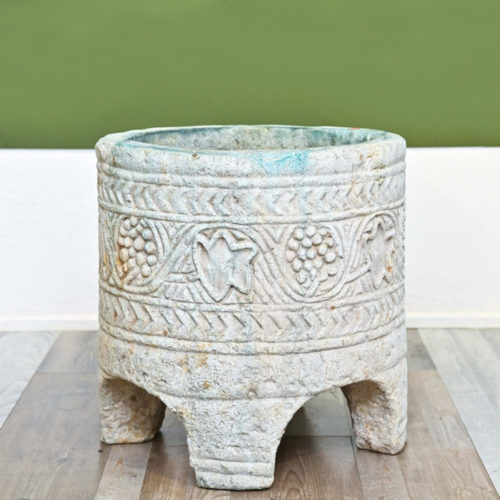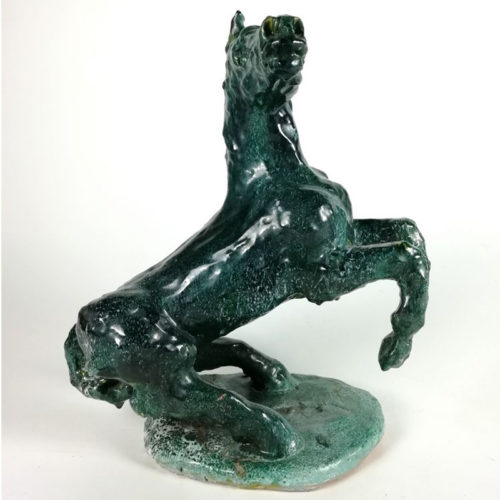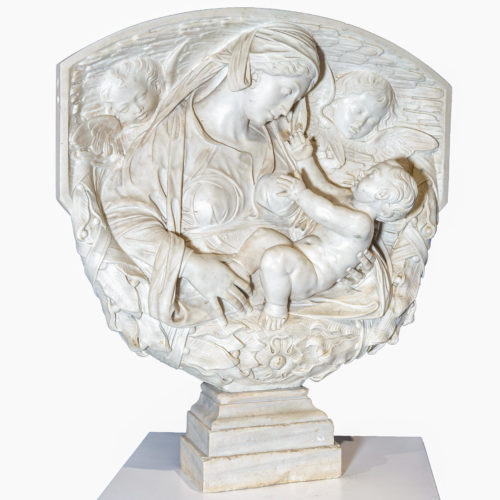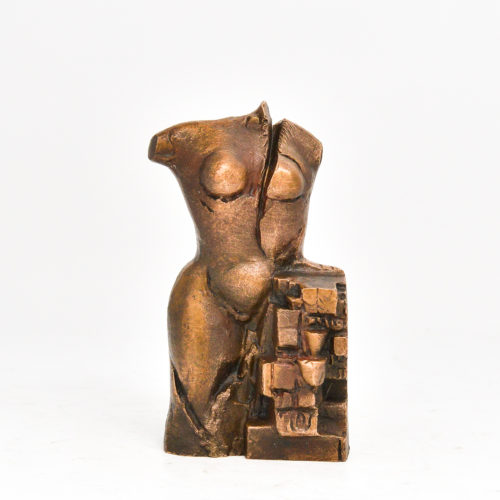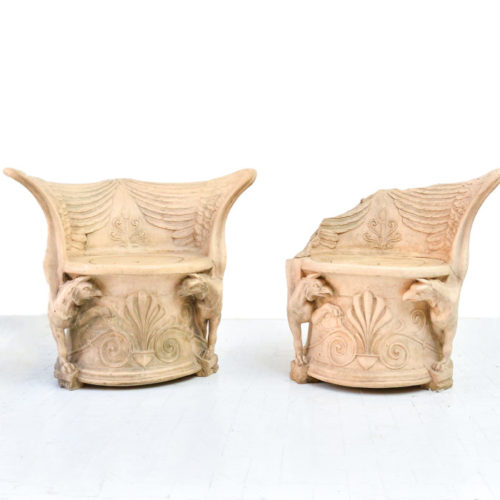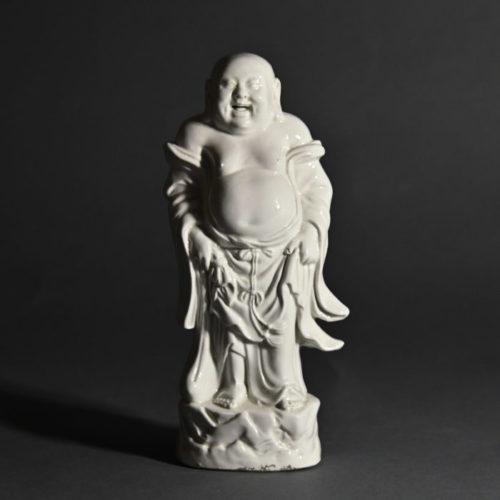Terracotta panel depicting a classical scene. On the back the Manifattura di Signa brand. In excellent condition.
The Manifattura di Signa is a historic terracotta pottery workshop. It was created in 1895 by the will of Camillo Bondi.
"At the beginning of the twentieth century Signa was still one of the major industrial centers of straw. To that industry, which had made the name of the town known beyond national borders, was added another activity which, since the last five years of the nineteenth century and in a short space of years, it would have relaunched its name on the European and American markets: the artistic terracotta industry "Manifattura di Signa", founded in Signa (Florence), in 1895 by Camillo Bondi, on the premises of the factory " Fornaci di Signa "owned by his brother Angelo. At that time, the taste for antique fakes continued to seduce with all its charm, and in ceramics the interest in tradition had prompted the most important Italian manufacturers to revisit shapes and decorations Renaissance, reaching the ancient virtuosity of the historiated and grotesques with a high craftsmanship. If those productions interpreted the ancient with typical nineteenth-century eclecticism, the Manifattura di Signa on the other hand, it generated the perfect resemblance of the truth, both through the forms used when possible on the original, and by means of patinas simulating those of marbles and bronzes and even the faults of time, in order to obtain the appearance of the authentic piece, and visually as well as tactile and, in some bronzes, also sound. With this spirit, reproductions of sculptural and decorative masterpieces of all times will take shape from the Arno mud: from Etruscan to Greek statuary, from Roman to Renaissance, from Moorish vases to contemporary Art Nouveau creations. The success that ensued is witnessed by numerous exhibition awards such as the medal at the Universal Expo in Paris in 1900, where he exhibited numerous plastic terracotta, suitable for decorating the exteriors, with a particular patination that made it look better and more resistant to agents. atmospheric, soon expanded the number of occupations and the specialization of young artists assisted by the experience of sculptors of excellent fame, called to Signa for new ideas by the Bondi brothers, the brilliant founders and conductors of the Manufacture, coming from a family of Leghorn Jewish high bourgeoisie and close to the intellectual and anti-positivist environment of the Florentine magazine of “Il Marzocco”. With the new industry an informal school of young workers was thus generated in the Signe who, despite lacking regular education, growing under the experience of sculptors and in contact with the most sublime models of universal classicism, a real concentrate of museums in the world , were naturally stimulated and educated in the beauty and proportions of forms, so much so that they became refined craftsmen, plasticizers, sculptors, able to give life to other similar manufactories. "
There are many artists who have collaborated with the Signa Manufacture: Oreste Calzolari, Giovanni Prini, Giulio Cantalamessa, Adolf von Hildebrand, Raffaello Romanelli, Giuseppe Santelli, Renato Bertelli, Giovan Battista Casanova, Bruno Catarzi, Italo Griselli
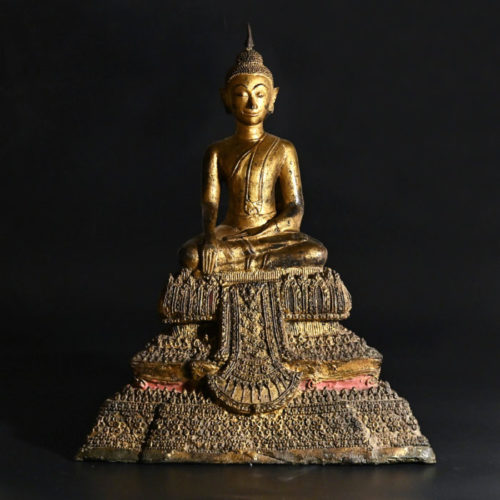 Late Ayutthaya gilt bronze Buddha, produced in Siam around 1780. With authentication from the Oriental Art Department, Antique Silver (18a Northampton square, London, E.C. 1). The kingdom of Ayutthaya was a state in Siam, present-day Thailand, which existed between 1351 and 1767. It took its name from its capital, Ayutthaya. The Buddha rests on a multi-layered base, and is represented in the "bhumisparsamudra" position, his right hand resting on his knee with the palm downwards and with the tips of the fingers touching the ground in such a way as to symbolise contact with the divinity of the earth, while the left hand is resting on his lap. With this gesture (mudrā) he demonstrated the attainment of enlightenment. On the top of his head Bhudda has a flame-shaped protuberance, called "uṣṇīṣa", which represents the radiance of spiritual energy. Period: circa 1780 Measurements: H 39.5 x W 32.5 x D 22 cm
Late Ayutthaya gilt bronze Buddha, produced in Siam around 1780. With authentication from the Oriental Art Department, Antique Silver (18a Northampton square, London, E.C. 1). The kingdom of Ayutthaya was a state in Siam, present-day Thailand, which existed between 1351 and 1767. It took its name from its capital, Ayutthaya. The Buddha rests on a multi-layered base, and is represented in the "bhumisparsamudra" position, his right hand resting on his knee with the palm downwards and with the tips of the fingers touching the ground in such a way as to symbolise contact with the divinity of the earth, while the left hand is resting on his lap. With this gesture (mudrā) he demonstrated the attainment of enlightenment. On the top of his head Bhudda has a flame-shaped protuberance, called "uṣṇīṣa", which represents the radiance of spiritual energy. Period: circa 1780 Measurements: H 39.5 x W 32.5 x D 22 cm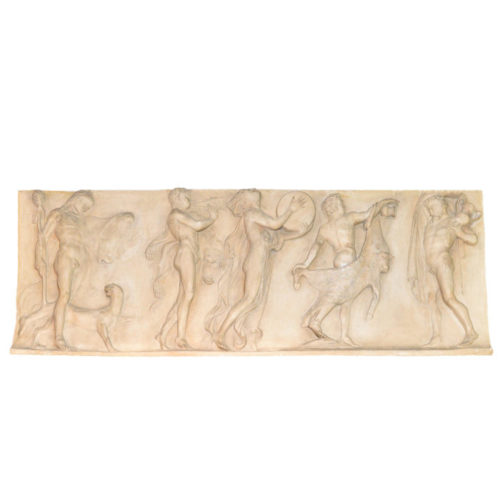 Period: Early 1900s Measurements: H 58 x W 157 x D 10 cmTerracotta panel depicting a classical scene. On the back the Manifattura di Signa brand. In excellent condition. The Manifattura di Signa is a historic terracotta pottery workshop. It was created in 1895 by the will of Camillo Bondi. "At the beginning of the twentieth century Signa was still one of the major industrial centers of straw. To that industry, which had made the name of the town known beyond national borders, was added another activity which, since the last five years of the nineteenth century and in a short space of years, it would have relaunched its name on the European and American markets: the artistic terracotta industry "Manifattura di Signa", founded in Signa (Florence), in 1895 by Camillo Bondi, on the premises of the factory " Fornaci di Signa "owned by his brother Angelo. At that time, the taste for antique fakes continued to seduce with all its charm, and in ceramics the interest in tradition had prompted the most important Italian manufacturers to revisit shapes and decorations Renaissance, reaching the ancient virtuosity of the historiated and grotesques with a high craftsmanship. If those productions interpreted the ancient with typical nineteenth-century eclecticism, the Manifattura di Signa on the other hand, it generated the perfect resemblance of the truth, both through the forms used when possible on the original, and by means of patinas simulating those of marbles and bronzes and even the faults of time, in order to obtain the appearance of the authentic piece, and visually as well as tactile and, in some bronzes, also sound. With this spirit, reproductions of sculptural and decorative masterpieces of all times will take shape from the Arno mud: from Etruscan to Greek statuary, from Roman to Renaissance, from Moorish vases to contemporary Art Nouveau creations. The success that ensued is witnessed by numerous exhibition awards such as the medal at the Universal Expo in Paris in 1900, where he exhibited numerous plastic terracotta, suitable for decorating the exteriors, with a particular patination that made it look better and more resistant to agents. atmospheric, soon expanded the number of occupations and the specialization of young artists assisted by the experience of sculptors of excellent fame, called to Signa for new ideas by the Bondi brothers, the brilliant founders and conductors of the Manufacture, coming from a family of Leghorn Jewish high bourgeoisie and close to the intellectual and anti-positivist environment of the Florentine magazine of “Il Marzocco”. With the new industry an informal school of young workers was thus generated in the Signe who, despite lacking regular education, growing under the experience of sculptors and in contact with the most sublime models of universal classicism, a real concentrate of museums in the world , were naturally stimulated and educated in the beauty and proportions of forms, so much so that they became refined craftsmen, plasticizers, sculptors, able to give life to other similar manufactories. " There are many artists who have collaborated with the Signa Manufacture: Oreste Calzolari, Giovanni Prini, Giulio Cantalamessa, Adolf von Hildebrand, Raffaello Romanelli, Giuseppe Santelli, Renato Bertelli, Giovan Battista Casanova, Bruno Catarzi, Italo Griselli
Period: Early 1900s Measurements: H 58 x W 157 x D 10 cmTerracotta panel depicting a classical scene. On the back the Manifattura di Signa brand. In excellent condition. The Manifattura di Signa is a historic terracotta pottery workshop. It was created in 1895 by the will of Camillo Bondi. "At the beginning of the twentieth century Signa was still one of the major industrial centers of straw. To that industry, which had made the name of the town known beyond national borders, was added another activity which, since the last five years of the nineteenth century and in a short space of years, it would have relaunched its name on the European and American markets: the artistic terracotta industry "Manifattura di Signa", founded in Signa (Florence), in 1895 by Camillo Bondi, on the premises of the factory " Fornaci di Signa "owned by his brother Angelo. At that time, the taste for antique fakes continued to seduce with all its charm, and in ceramics the interest in tradition had prompted the most important Italian manufacturers to revisit shapes and decorations Renaissance, reaching the ancient virtuosity of the historiated and grotesques with a high craftsmanship. If those productions interpreted the ancient with typical nineteenth-century eclecticism, the Manifattura di Signa on the other hand, it generated the perfect resemblance of the truth, both through the forms used when possible on the original, and by means of patinas simulating those of marbles and bronzes and even the faults of time, in order to obtain the appearance of the authentic piece, and visually as well as tactile and, in some bronzes, also sound. With this spirit, reproductions of sculptural and decorative masterpieces of all times will take shape from the Arno mud: from Etruscan to Greek statuary, from Roman to Renaissance, from Moorish vases to contemporary Art Nouveau creations. The success that ensued is witnessed by numerous exhibition awards such as the medal at the Universal Expo in Paris in 1900, where he exhibited numerous plastic terracotta, suitable for decorating the exteriors, with a particular patination that made it look better and more resistant to agents. atmospheric, soon expanded the number of occupations and the specialization of young artists assisted by the experience of sculptors of excellent fame, called to Signa for new ideas by the Bondi brothers, the brilliant founders and conductors of the Manufacture, coming from a family of Leghorn Jewish high bourgeoisie and close to the intellectual and anti-positivist environment of the Florentine magazine of “Il Marzocco”. With the new industry an informal school of young workers was thus generated in the Signe who, despite lacking regular education, growing under the experience of sculptors and in contact with the most sublime models of universal classicism, a real concentrate of museums in the world , were naturally stimulated and educated in the beauty and proportions of forms, so much so that they became refined craftsmen, plasticizers, sculptors, able to give life to other similar manufactories. " There are many artists who have collaborated with the Signa Manufacture: Oreste Calzolari, Giovanni Prini, Giulio Cantalamessa, Adolf von Hildebrand, Raffaello Romanelli, Giuseppe Santelli, Renato Bertelli, Giovan Battista Casanova, Bruno Catarzi, Italo Griselli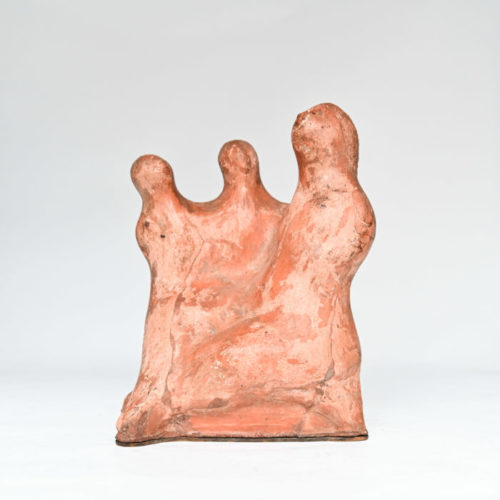 Period: 1949 Measurements: H 35 x W 26 x D 20 cmTerracotta sculpture by Carmelo Cappello (Ragusa, 21 May 1912 - Milan, 21 December 1996) signed and dated 1949. CARMELO CAPPELLO (Ragusa 1912 - Milan 1996) He attended the Comiso School of Art. Trained at a very young age in Ettore Colla's studio, he moved to Milan in the 30th. Thanks to a scholarship he follows the courses of Marino Marini at the Istituto Superiore di Monza. In 37 he made his debut as a sculptor and the following year he held his first solo show at the Bragaglia Gallery in Rome. In 41 he consolidated his friendship with Giò Ponti, which later became a close collaboration. He has participated numerous times in the Venice Biennale, the Rome Quadriennale and the Milan Triennale. In 59 he was invited to Documenta 2 in Kassel. After the first figurative phase, struck by Moore's modern European sculpture, he passes from Tatlin's Russian Constructivism to the discoveries of the filtering space of Pevsner, Brancusi and Gabo: these are the cultural matrices, in his artistic iter, of his original declination of pure linear rhythms and volumetric that constitute the fulcrum of his mature language. Constant components of its structures are the curve, linked in the circle or marked in the ellipsis, in a rigorous equilibrium of two-dimensional relationships. In Ragusa, in 94, the Civic Collection Cappello was inaugurated, the result of the donation of 15 sculptures and 20 graphic works that formed the starting point of the Museum dedicated to him in 55. Good production of multiples and graphics of his maturity.
Period: 1949 Measurements: H 35 x W 26 x D 20 cmTerracotta sculpture by Carmelo Cappello (Ragusa, 21 May 1912 - Milan, 21 December 1996) signed and dated 1949. CARMELO CAPPELLO (Ragusa 1912 - Milan 1996) He attended the Comiso School of Art. Trained at a very young age in Ettore Colla's studio, he moved to Milan in the 30th. Thanks to a scholarship he follows the courses of Marino Marini at the Istituto Superiore di Monza. In 37 he made his debut as a sculptor and the following year he held his first solo show at the Bragaglia Gallery in Rome. In 41 he consolidated his friendship with Giò Ponti, which later became a close collaboration. He has participated numerous times in the Venice Biennale, the Rome Quadriennale and the Milan Triennale. In 59 he was invited to Documenta 2 in Kassel. After the first figurative phase, struck by Moore's modern European sculpture, he passes from Tatlin's Russian Constructivism to the discoveries of the filtering space of Pevsner, Brancusi and Gabo: these are the cultural matrices, in his artistic iter, of his original declination of pure linear rhythms and volumetric that constitute the fulcrum of his mature language. Constant components of its structures are the curve, linked in the circle or marked in the ellipsis, in a rigorous equilibrium of two-dimensional relationships. In Ragusa, in 94, the Civic Collection Cappello was inaugurated, the result of the donation of 15 sculptures and 20 graphic works that formed the starting point of the Museum dedicated to him in 55. Good production of multiples and graphics of his maturity.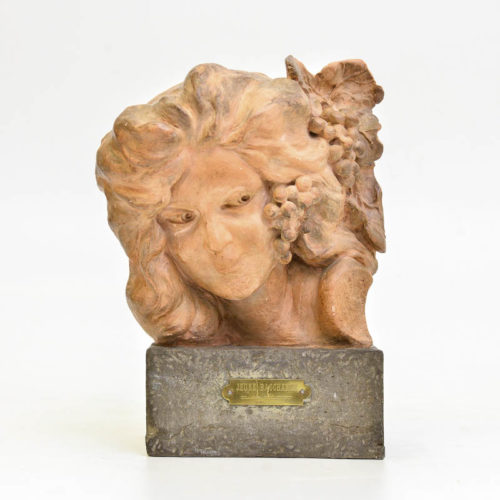 Beautiful liberty style terracotta sculpture depicting a girl's head, entitled "Jeune Bacchante". Dated 1914 and signed on the back by the author Claire Jeanne Robertine Colinet (1880-1950). The sculptress was born in Brussels in 1880 and studied sculpture with the artist Jef Lambeaux. His favorite subjects were exotic dancers, cabarets and circus performers. The female figures in Claire Colinet's sculptures are tiny, muscular and dramatic. Colinet held his first exhibition in 1913 at the Salon de Artistes Francois. Period: 1914 Measurements: H 41 x L 26,5 x P 24 cm
Beautiful liberty style terracotta sculpture depicting a girl's head, entitled "Jeune Bacchante". Dated 1914 and signed on the back by the author Claire Jeanne Robertine Colinet (1880-1950). The sculptress was born in Brussels in 1880 and studied sculpture with the artist Jef Lambeaux. His favorite subjects were exotic dancers, cabarets and circus performers. The female figures in Claire Colinet's sculptures are tiny, muscular and dramatic. Colinet held his first exhibition in 1913 at the Salon de Artistes Francois. Period: 1914 Measurements: H 41 x L 26,5 x P 24 cm